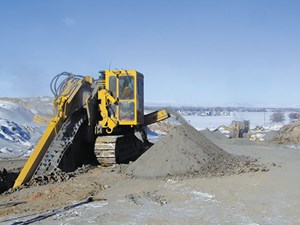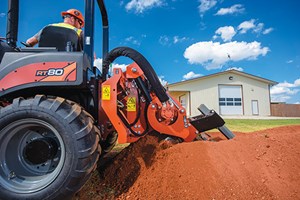May 2023 Vol. 78 No. 5
Features
Trenchless methods: Trenchers remain valuable for utility construction
Jeff Griffin | Senior Editor
(UI) — In the 1970s, new residential developments were being built with all utilities underground. Of course, water, sewer, and gas lines always had been buried, but now telephone and electric dissertation wires were, too, as would cable television services that would come later.
All utilities underground became a selling point: no unsightly utility poles and overhead wires; no downed and dangerous utility lines from severe storms.
Most of the underground construction was done with compact utility trenches, small walk-behind marine and larger riding trenchers. Bigger trenchers made longer runs.
Vibratory plows began to play an increasingly important role. When conditions were suitable, the narrow slit left in the ground by the plow blade was easier to restore after the installation. But a plow blade could strike and damage any existing utility in its path.
Today, most project articles in industry trade magazines tend to cover trenchless methods, horizontal directional drilling (HDD), pipe bursting and various rehabilitation methods. Have the various trenchless technologies made trenching equipment obsolete?
The answer is a loud “No.”
Trenchers that dig a relatively narrow trench to the depth necessary for each type of utility, remain the fastest, least costly method of putting utilities in the ground. An important added benefit trenching offers is when circumstances are right, multiple utilities can be placed in the same trench, reducing costs for all participating companies.
Two companies – Ditch Witch and Vermeer – dominate this market and representatives of both companies say that trenchers are essential for installing underground utilities.
Steve Seabolt, category manager for Ditch Witch trenchers, and Ed Savage, Vermeer product manager, discussed with Underground Infrastructure the importance of trenchers for utility construction today.
Have trenchless technologies made trenching obsolete for utility construction?
Seabolt: Trenching and other types of open-cut methods are popular solutions for installation of cable or pipe products over long distances, in areas with minimal surface obstructions. They are also selected often for extremely short or shallow jobs, such as a “drop” from street to home, or for installation of a lawn sprinkler system.
Trenchers are the go-to solution if the design of the job requires the product be Tee’d, branched, joined, or physically manipulated in some other way during installation. Trenchers (and sometimes plows) are often chosen when there are requirements for sand to be placed above or below the product.
Plows, in particular, are capable of installing small-diameter pipes or cables at a very fast pace, compared to most other methods, and are often the installation tool of choice when productivity is critical. Saws, or disc trenchers, are often selected when installing product in solid rock or frozen ground, especially for short or shallow distances. Microtrenchers are chosen to cut asphalt roadways when the roadside easement is crowded or covered with surface obstructions that might inhibit setup of an HDD rig.
Savage: Horizontal directional drilling does get a lot of attention for installing underground utilities, but dedicated trenchers still play a significant role in the installation process. Trenchers and vibratory plows are widely used to install utilities over long distances in more rural areas, where there are fewer restoration requirements.
Small walk-behind trenchers and vibratory trenchers are often used to install electrical, telecom, water and gas lines to homes and businesses. Mid-size rubber tire/track trenchers and vibratory plows are employed on longer installation projects. Large trenchers are an excellent option for utility jobs in challenging rocky grounds.
Also, trenching tends to be the preferred method for installing new utilities on greenfield development projects, where existing underground infrastructure might be limited.
What factors influence whether trenching or HDD will be used?
Seabolt: Ground conditions, depth, distance, product being installed, padding (beneath the pipe) or special cover requirements like sand, surface obstructions, desired speed, skilled labor availability are among the considerations.
Savage: The main factor contractors should use to determine whether to trench or use a horizontal directional drill is location.
In urban areas, there are typically more above-ground obstacles like roads, driveways and buildings that contractors have to account for. So, using trenchless installation methods like horizontal directional drilling, auger boring and piercing tools tends to be more efficient than cutting through hard surfaces and then repairing them.
Rural areas have fewer road intersections and other obstacles. Trenching or using a vibratory plow in these areas is typically faster than using HDD alone. Drills are still often used to make road and river crossings.
Other factors that contractors should think about are the utility bundle size, installation depth and ground conditions. These will influence the size of the trencher, vibratory plow or HDD used on a job.
For example, if a contractor is installing small-diameter electrical or fiber lines at a shallow depth in soft soil conditions, a vibratory plow is likely the best option. However, if installing larger distribution lines and depths of more than a few feet, contractors will likely need to choose a mid-size trencher.
In rock and when installing large-diameter products at depths greater than 5 feet, they may consider using a higher horsepower trencher with a larger boom and chain configuration that allows them to cut a trench the required width.
One more consideration that can influence the decision between HDD and trenching is equipment availability. Unlike directional drills, trenchers are typically available at rental stores. Renting can be an attractive solution if the contractor only has a minimal amount of product to install.
What are the most common applications for trenchers?
Seabolt: Water, sewer, power, gas and telecommunications, including coaxial and fiber optic cables.
What sizes of trenchers are used for utility work?
Seabolt: Smaller walk behind trenchers and stand-on mini skid steers are often used for short/shallow electrical installations, yard lights, buried dog fences, and household power connections. Bigger ride-on trenchers are used for longer runs, tougher conditions, and/or deeper depth requirements.
Savage: Everything from small pedestrian trenchers to large trenchers with a track undercarriage is used to perform electrical work. The size of the unit depends on where the work is being done, the installation depth and the size of the electrical bundle. Pedestrian trenchers are used for doing electrical drops at homes and businesses. Midsize trenchers are typically used for small electrical distribution line installations over greater distances in soft ground conditions. Large trenchers are used for installing large electrical distribution and transmission lines in rocky grounds.
What types of trenching drives and digging components are used for utility work?
Seabolt: Most trenchers doing electrical installations are either gasoline or diesel powered, with only the smallest units using gasoline. The power is typically transmitted hydraulically except on the biggest of rock trenchers, which often use mechanical power transmission to maximize the digging force available and overall productivity.
Units are available with tires, rubber tracks, steel tracks and quad tracks, so the customer should think about the need for drawbar, flotation, turf preservation, terrain, soil moisture, inclement weather operation, maneuverability, and then discuss the best solution with an expert at the local trencher dealership.
Most trenchers utilize digging chains, but a few use wheels or discs. Bucket wheels are for soft soils and wide ditches, disc “saws” are most often for rock or asphalt, and microtrenchers utilize a smaller-diameter disc for cutting asphalt while simultaneously removing the spoils. This leaves a narrow, clean ditch, perfect for small-diameter conduit or direct-bury cables.
Savage: The cutting system on a trencher is dependent on project needs. On many mid-size trenchers, attachments can be swapped out. Contractors can outfit the tractor with a chain trencher, a rock wheel or micro-trencher, a vibratory plow or even a backhoe. On some large trenchers with track undercarriages, the chain trencher can be swapped with a rock wheel or bucket wheel.
How would you summarize the role and importance of underground work in the utility market?
Seabolt: The trend toward underground power installation (or “undergrounding” existing power lines) continues to accelerate, thanks to a desire among community members, legislators and service providers to avoid power outages, fires and the other challenges experienced with overhead power distribution.
Savage: There are several exciting opportunities for contractors doing electrical installation work. Many public utility companies have announced plans to “harden” (underground) thousands of miles of electrical transmission and distribution lines, and trenchers will have a significant role in making that happen.
There is also a lot of work for electrical contractors in the renewable energy market, including solar and wind farms. A major part of these projects involves connecting each site to the electrical grid. On solar farms, electrical lines need to be installed under each row of panels to transport captured energy.
And finally, as more electric vehicles (EVs) take to the highway, the world will need more recharging stations. Fast-charging stations and the ability to charge several vehicles at one site often require larger electrical lines than what’s currently running to these sites. This is another area where there is potential growth in the coming years.
Has HDD limited the need for trenching?
Seabolt: Traditional open-cut trenching is a very complementary tool to the HDD, so each has its own place and benefits.
Savage: HDD hasn’t limited the volume of trenching happening in the world. It has simply given contractors an alternative method of performing underground work that may have been limited in the past. In many environments, the costs of restoration and/or access to the area may have prevented a utility from being installed underground before HDD. Trenchless methods have expanded the volume of utilities installed underground, and the two methods (HDD and trenching) are often used together to get the work done.
What range of equipment does your company manufacture for electrical?
Seabolt: Ditch Witch manufactures small walk-behind trenchers, stand-on mini skid steers, and ride-on “utility” tractors. Most of the bigger units are available with a variety of purpose-built attachments, including vibratory plows, chain trenchers, rock saws, and microtrenchers.
The newest Ditch Witch micro-trencher, MT26, digs 26 inches deep and was developed to answer the needs voiced by electrical and telecommunications contractors installing power and fiber for 5G towers, since the national electrical code requires 24-inch of cover over the power in those situations.
Savage: Vermeer manufactures a full range of equipment for installing electrical lines underground. Vermeer trenchers come in a wide range of sizes – from 13-horsepower pedestrian trenchers up to massive 600-horsepower trenchers that can cut a ditch 15 feet deep and 48-inches wide.
The company’s HDD line for electrical work starts at the 8,000-pound class utility-sized Vermeer D8x12 horizontal directional drill, ideal for doing short bores in urban areas, and extends to the 500,000-pound class maxi rig for making long-distance electrical transmission and distribution installations.
In addition, Vermeer offers utility locators, vacuum excavators and core saws to assist with utility locating.
FOR MORE INFORMATION:
Ditch Witch, (800) 654-6481, ditchwitch.com
Vermeer Corp., (888) 837-6337, vermeer.com






Comments